| Image | Name | Town or city | County | Years built | Style | Years in use | Reference |
|---|
 | Avon House | Bristol | Avon | 1969-1972 | International style | 1974-1996: Avon County Council (council abolished)
1996-1999: Bristol City Council
1999–present: private use as a hotel | [3] |
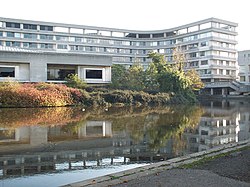 | County Hall | Bedford | Bedfordshire | 1965-1969 | Brutalist style | 1970-2009: Bedfordshire County Council (council abolished)
2009–present: Bedford Borough Council | [4] |
 | Shire Hall | Reading | Berkshire | 1981 | Brutalist style | 1981-1998: Berkshire County Council
2000-2017: Foster Wheeler AG
2017-present: John Wood Group plc | [5] |
 | City Hall | Bristol | Bristol | 1938-1952 | Neo-Georgian style | 1956–present: Bristol City Council | [6] |
 | County Hall | Aylesbury | Buckinghamshire | 1964-1966 | Brutalist style | 1966-2020: Buckinghamshire County Council
2020–present Buckinghamshire Council | [7] |
 | Shire Hall | Cambridge | Cambridgeshire | 1932 | Neo-Georgian style | 1932-2020: Cambridgeshire County Council
2020–present: hotel and office development | [8] |
 | New Shire Hall | Alconbury Weald | Cambridgeshire | 2019-2020 | Modern style | 2020–present: Cambridgeshire County Council | [9] |
 | County Hall | Chester | Cheshire | 1938-1957 | Neo-Georgian style | 1957-2009: Cheshire County Council (council abolished)
2009–present: University of Chester | [10] |
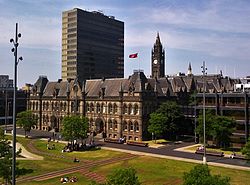 | Municipal Buildings | Middlesbrough | Cleveland | 1883-1889 | French Gothic Style | 1889-1968: Middlesbrough Borough Council (council abolished)
1968-1974: Teesside County Borough Council (council abolished)
1974-1996: Cleveland County Council (council abolished)
1966–present: Middlesbrough Council | [11] |
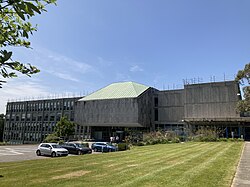 | Lys Kernow | Truro | Cornwall | 1966 | Brutalist style | 1966-2009: Cornwall County Council (council abolished)
2009–present: Cornwall Council | [12] |
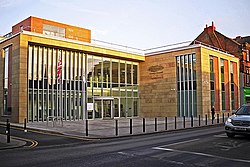 | Cumbria House | Carlisle | Cumberland / Cumbria | 2016 | Modern style | 2016-2023: Cumbria County Council
2023-present: Cumberland Council | [13] |
 | County Hall | Matlock | Derbyshire | 1867 | Victorian neo-gothic | 1867-1955: Smedley's Hydropathic Hospital
1955–present: Derbyshire County Council | [14] |
 | County Hall | Exeter | Devon | 1958-1964 | Neo-classical style | 1964–present: Devon County Council | [15] |
 | County Hall | Dorchester | Dorset | 1938-1955 | Art Deco style | 1955-2019: Dorset County Council
2019–present: Dorset Council | [16] |
 | County Hall | Durham | County Durham | 1960-1963 | Brutalist style | 1963–present: Durham County Council | [17] |
 | County Hall | Lewes | East Sussex | 1968 | Modern style | 1968-present: East Sussex County Council
Also used by Lewes District Council | [18] |
 | County Hall | Beverley | East Riding of Yorkshire | 1881 | Flemish Renaissance style | 1889-1974: East Riding County Council
1974-1996: Humberside County Council
1996–present: East Riding of Yorkshire Council | [19] |
 | County Hall | Chelmsford | Essex | 1909 | Neo-classical style | 1909–present: Essex County Council | [20] |
 | Shire Hall | Gloucester | Gloucestershire | 1816 | Neo-classical style | 1816–present: Gloucestershire County Council | [21] |
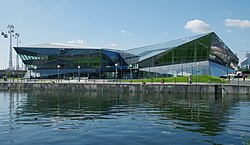 | City Hall | London | Greater London | 2012 | Modern style | 2012-present: Greater London Authority | [22] |
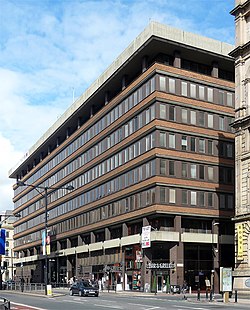 | County Hall | Manchester | Greater Manchester | 1973 | Modern style | 1974-1986: Greater Manchester County Council
1986-present: Commercial offices | [23] |
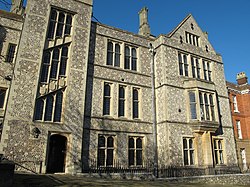 | Castle Hill | Winchester | Hampshire | 1833 | Elizabethan style | 1889-present: Hampshire County Council | [24] |
 | Shirehall | Hereford | Herefordshire | 1817 | Neo-classical style | 1889-1974: Herefordshire County Council
1998-present: Herefordshire Council | [25] |
 | County Hall | Hertford | Hertfordshire | 1939 | Neo-Georgian style with Scandinavian elements | 1939–present: Hertfordshire County Council | [26] |
 | County Hall | Boston | Holland | 1927 | Gothic Revival style | 1927-1974: Holland County Council
1974-present:Public library | [27] |
 | Walden House | Huntingdon | Huntingdonshire | 1674 | Jacobean style | 1889-1965: Huntingdonshire County Council
1965-1974: Huntingdon and Peterborough County Council
1974–present: Municipal offices and then private apartments | [28] |
 | County Hall | March | Isle of Ely | 1909 | Edwardian style | 1909-1965: Isle of Ely County Council
1974-present: Fenland District Council | [29] |
 | County Hall | Newport | Isle of Wight | 1938 | Neo-Georgian style | 1938–present: Isle of Wight County Council | [30] |
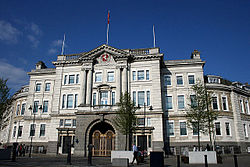 | County Hall | Maidstone | Kent | 1824 | Greek Revival style | 1889-present: Kent County Council | [31] |
 | County Offices | Sleaford | Kesteven | 1856 | Italianate style | 1925-1974: Kesteven County Council
1974-present: North Kesteven District Council | [32] |
 | County Hall | Preston | Lancashire | 1882 | Queen Anne revival style | 1889-present: Lancashire County Council | [33] |
 | County Hall | Glenfield | Leicestershire | 1967 | Brutalist style | 1967-present: Leicestershire County Council | [34] |
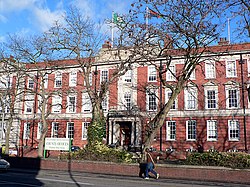 | County Offices | Lincoln | Lindsey / Lincolnshire | 1932 | Neo-Georgian style | 1932-1974: Lindsey County Council
1974-present: Lincolnshire County Council | [35] |
 | The Guildhall | Westminster | Middlesex | 1913 | Neo-Gothic style | 1913-1965: Middlesex County Council
1965-2009: Used as a court
2009–present: Supreme Court of the United Kingdom | [36] |
 | Metropolitan House | Liverpool | Merseyside | 1974 | Modern style | 1974-1986: Merseyside County Council
1986-present: Commercial offices | [37] |
 | County Hall | Norwich | Norfolk | 1968 | Modern style | 1968-present: Norfolk County Council | [38] |
 | County Hall | Northampton | Northamptonshire | 1845 | Neo-classical style | 1899-2021: Northamptonshire County Council
2021-present: Tourist Information Centre | [39] |
 | County Hall | Morpeth | Northumberland | 1981 | Modern style | 1981-present: Northumberland County Council | [40] |
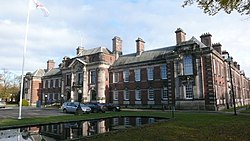 | County Hall | Northallerton | North Yorkshire | 1906 | Edwardian Baroque style | 1906-1974: North Riding County Council
1974-present: North Yorkshire County Council | [41] |
 | County Hall | Nottingham | Nottinghamshire | 1954 | Modern style | 1954-present: Nottinghamshire County Council | [42] |
 | County Hall | Oxford | Oxfordshire | 1841 | Gothic Revival style | 1899–present: Oxfordshire County Council | [43] |
 | Catmose House | Oakham | Rutland | 1781 | Neo-classical style | 1899-1974: Rutland County Council
1997-present: Rutland County Council | [44] |
 | Shirehall | Shrewsbury | Shropshire | 1966 | Modern style | 1966-present: Shropshire County Council | [45] |
 | County Hall | Taunton | Somerset | 1935 | Neo-Georgian style | 1935–present: Somerset County Council | [46] |
 | County Hall | Barnsley | South Yorkshire | 1960 | Brutalist style | 1974-1986: South Yorkshire County Council
1974-2015: Commercial offices (demolished in 2015) | [47] |
 | County Buildings | Stafford | Staffordshire | 1895 | Baroque revival style | 1899–present: Staffordshire County Council | [48] |
 | Endeavour House | Ipswich | Suffolk | 2003 | Modern style | 2003-present: Suffolk County Council | [49] |
 | Woodhatch Place | Reigate | Surrey | 1999 | Modern style | 2020-present: Surrey County Council | [50] |
 | Sandyford House | Newcastle upon Tyne | Tyne and Wear | 1974 | Brutalist style | 1974-1986: Tyne and Wear County Council
1986-present: Commercial offices | [51] |
 | Shire Hall | Warwick | Warwickshire | 1758 | Neo-classical style | 1899–present: Warwickshire County Council | [52] |
 | County Hall | Birmingham | West Midlands | 1970 | Brutalist style | 1974-1986: West Midlands County Council
1986-present: Commercial offices | [53] |
 | County Hall | Kendal | Westmorland | 1939 | Neo-Georgian style | 1939-1974: Westmorland County Council
1974-2024: Municipal offices | [54] |
 | County Hall | Chichester | West Sussex | 1933 | Neo-Georgian style | 1933–present: West Sussex County Council | [55] |
 | County Hall | Wakefield | West Yorkshire | 1898 | Gothic Revival style | 1898-1974: West Riding County Council
1974-1986: West Yorkshire County Council
1986-present: Wakefield Metropolitan District Council | [56] |
 | County Hall | Trowbridge | Wiltshire | 1940 | Neo-Georgian style | 1940–present: Wiltshire County Council | [57] |
 | County Hall | Worcester | Worcestershire | 1978 | Brutalist style | 1978-1998: Hereford and Worcester County Council
1998-present: Worcestershire County Council | [58] |























































